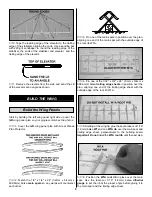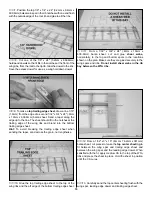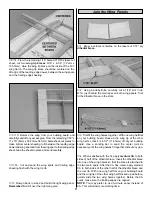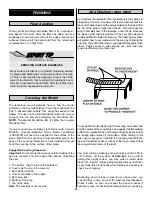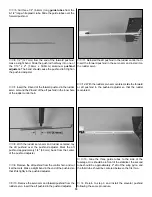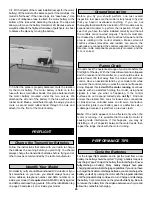
❏
1. Reinstall the wire landing gear over the fuselage,
positioned under the pylon forward plate.
❏
2. Glue a 1/8" x 1/8" x 3/8" (3.2mm x 3.2mm x
9.5mm)long balsa stick on each side of the fuselage, in front
of the landing gear wire.
❏
3. Slide the
1-1/2" wheels
onto each side of the landing
gear wire. Press a nylon
wheel collar
onto the wire landing
gear to secure the wheels.
❏
1. Adjust the position of the pushrods at the servo horns
and the control horns to change the amount of throw. You
may also use the ATV’s if your transmitter has them.
Note: This section is VERY important and must NOT be
omitted! A model that is not properly balanced will be
unstable and possibly unflyable.
❏
1. Accurately mark the balance point on the bottom of the
wing on both sides of the fuselage. The
balance point
(C.G.)
is shown on the fuse plan and is located
1-15/16"
back from the leading edge
of the wing. This is the
balance point at which your model should balance for your
first flights. After the initial trim flights and when you become
more acquainted with your Basic Light Trainer, you may
wish to experiment by shifting the balance up to 1/4"
forward
or
backward
to change its flying characteristics.
Moving the balance
forward
may improve the smoothness
and stability, but the model may then require more speed for
takeoff and may become more difficult to slow down for
landing. Moving the balance
aft
makes the model more
agile with a lighter, snappier “feel.” In any case,
please start
at the location we recommend. Do not at any time
balance your model outside the recommended range.
BALANCE YOUR MODEL
We recommend the following control surface throws:
Elevator:
5/8" up
5/8" down
Rudder:
7/8" left
7/8" right
IMPORTANT:
The balance and control throws for the Basic
Light Trainer have been extensively tested. This chart
indicates the settings at which the Basic Light Trainer flies
best. Please set up your model to the specifications listed
above. If, after you become comfortable with your Basic
Light Trainer and you would like to adjust the throws to suit
your tastes, that’s fine. Too much throw can make the plane
harder to handle or force it into a stall or snap roll, so
remember, “more is not always better.”
4-CHANNEL
TRANSMITTER
TRANSMITTER
4-CHANNEL
TRANSMITTER
4-CHANNEL
SET THE CONTROL THROWS
INSTALL THE LANDING GEAR
19
Содержание BLT
Страница 24: ...TWO VIEW...





